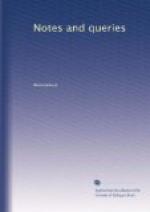The Opus Majus, as published by Jebb, contains but six parts; but the work in its complete state had originally a seventh part, containing Moral Philosophy, which was reproduced, in an abridged and improved state, by the renowned author, in the Opus Tertium. This is now ascertained, says M. Cousin, with unquestionable certainty, and for the first time, from the examination of the Douay MS.; which alludes, in the most precise terms, to the treatise on that subject. Hence the importance of endeavouring to discover what has become of the MS. Treatise of Moral Philosophy mentioned by Jebb, on the authority of Bale and Pits, as it is very likely to have been the seventh part of the Opus Majus. Jebb published the Opus Majus from a Dublin MS., collated with other MSS.; but he gives no description of that MS., only saying that it contained many other works attributed to Bacon, and in such an order that they seemed to form but one and the same work. It becomes necessary, therefore, to ascertain what were the different works of Bacon included in the Dublin MS.; which is, in all probability, the same mentioned as being in Trinity College, in the Catalogi Codicum Manuscriptorum Angliae et Hiberniae in unum Collecti: Folio. Oxon, 1697.
According to this Catalogue, a Treatise on Moral Philosophy forms part of Roger Bacon’s MSS. there enumerated; and if so, why did Jebb suppress it in his edition of the Opus Majus? Perhaps some of your correspondents in Dublin may think it worth the trouble to endeavour to clear up this difficulty, on which M. Cousin lays great stress; and recommends, at the same time, a new and complete edition of the Opus Majus to the patriotism of some Oxford or Cambridge Savant. He might well have included Dublin in his appeal for help in this undertaking; which, he says, would throw a better light on that vast, and not very intelligible monument of one of the most independent and greatest minds of the Middle Ages.
J.M.
Oxford, April 9th.
[Footnote 1: See Journal
des Savants, Mars, Avril, Mai, Juin,
1848.]
* * * * *
CRAIK’S ROMANCE OF THE PEERAGE.
If I knew where to address Mr. G.L. Craik, I should send him the following “Note:” if you think it deserves a place in your columns, it may probably meet his eye.
In the article on the Lady Arabella Stuart (Romance of the Peerage, vol. ii. p. 370.), a letter of Sir Ralph Winwood, dated 1610, is quoted, in which he states, that she is “not altogether free from suspicion of being collapsed.” On this Mr. Craik observes, “It is difficult to conjecture what can be here meant by collapsed, unless it be fallen off to Romanism.” Now it is not a little curious, and it proves Mr. Craik’s capability for the task of illustrating family history from the obscure allusions in letters and documents, that there exists cotemporary authority for fixing the meaning Mr. Craik has conjectured to be the true one, to the word collapsed. A pamphlet, with the title A Letter to Mr. T.H., late Minister, now Fugitive, was published in 1609, with a dedication to all Romish collapsed “ladies of Great Britain;” which bears internal evidence of being addressed to those who were converts from the Church of England to Romanism. {395}




